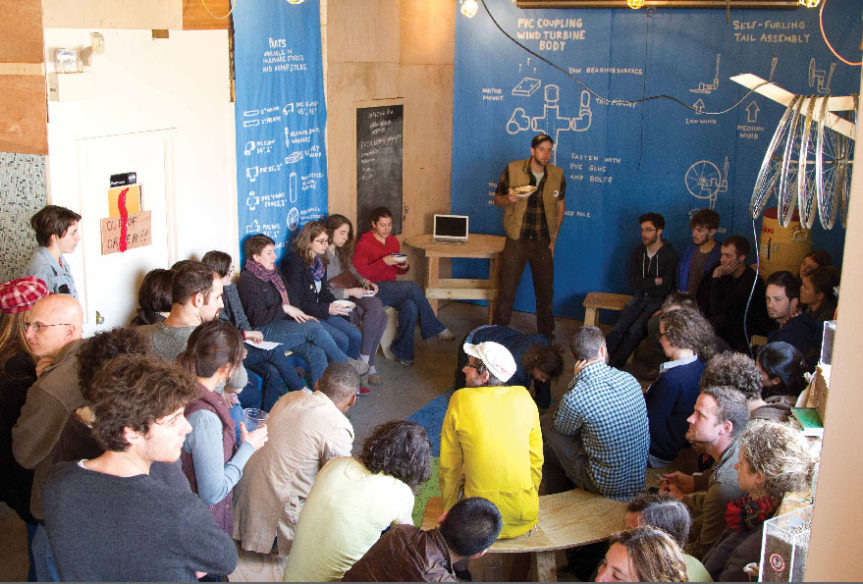This video piece, titled “THANK YOU”, was created based on the words and information I gathered while getting to know the workers at a landscape maintenance company. THANK YOU is an example of one message that a worker wanted to tell the world. As the video progresses the message is mowed into the grass then promptly mowed away. The piece gave workers a temporary platform to express their ideas and feelings – something not usually permitted to blue-collar labourers.
Author: amandali2014
-
Survival Tip: Advanced Tree Climbing

Tree climbing has been used for 1O’s of thousands of years. The primary purpose of climbing a tree was for gathering and hunting. 
Over the years different cultures have created their own unique ways of climbing trees. Most have developed special styles and tools to better able themselves to climb the type of trees specific to their region. One of these styles is the Japanese style of tree climbing. In this picture I am utilizing the Japanese style of tree climbing. This style involves finding a 4-6 diameter stick and weaving a rope around the stick and bark to attach them together to form a step. The process is repeated, to create additional steps forming a basic type of ladder to ease the process of climbing a tree. - A dead tree is an unsure tree. When approaching a tree it is important to make sure that it is alive all the way through. A dead tree is unsure, by that I mean its structural integrity is questionable.
2. Size does matter. The ideal tree size is a tree that you can comfortable wrap your hands around the diameter of the tree with your fingers intertwined, and your thumbs almost touching. If the tree is too thick you will be unable to create this grasp and will be unable to create the leverage needed to support your body weight leaving you unable to propel yourself up the tree. If if the tree is too thin it will simply break. The images above depict a tree that is too thin [left], a tree that is too thick [middle], and a demonstration of the hand grasp around a tree of the correct size [right].
3. Lose the shoes. This form of tree climbing requires the participant to be barefoot. The removal of shoes, allows for the ball of the individuals foot to be used in the climb. The benefit of being barefoot allows you to create friction between your foot and the tree bark. Therefore when you are selecting a tree it is also import to ensure that the tree bark is ruff to further aid you in the creation of this friction.
4. Ball planting. Notches on the tree are used as your theoretical latter. The balls of your feet are planted on top of these notches. These notches help support your weight and utilize lower body strength to assist you with the climb. Trees without notches are very difficult to climb.
5. Mounting. Before ascending the tree it is essential to test your strength. This safety strength test is performed by recreating the pose in the image above and holding it for 1O seconds. Your body will sway to gravitational forces. This sway will occur throughout your climb. You must be able to counteract this sway through the manipulation of your body.
6. Foot-hand-foot-hand. Now that you are mounted, tree asention can occur. It is important to make your way up the tree using the formula: right foot-right hand-left foot-left hand. This formula puts your body in proper alignment, lowering your center of gravity and as a result enhances your balance, decreasing strain on your back and upper shoulders.
The above image shows students of outdoor school participating in my very educational tree climbing tutorial using the steps described above.
-

Futurefarmers, Soil Kitchen, 2011
This is a Futurefarmers public art project. For this project they asked citizens for soil samples of their neighborhood in exchange for free soup. This project collected over 350 soil samples and served 300 bowls of soup per day. In addition to the soup for soil exchange Futurefarmers also conducted free workshops including wind turbine construction, urban agriculture, soil remediation, composting, lectures by soil scientists and cooking lessons.


 For more information visit: http://www.futurefarmers.com/#projects/soilkitchen
For more information visit: http://www.futurefarmers.com/#projects/soilkitchenPhiladelphia 2011
Venice Architecture Biennale
-
Futurefarmers
http://www.futurefarmers.com/
Here you can see there installations, projects, and exhibitions.
Futurefarmers is an international artist collective practicing a form of cultural activism that exploits the interactive potential offered by new media and public spaces.



















You must be logged in to post a comment.